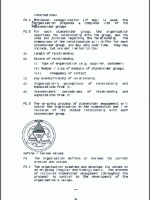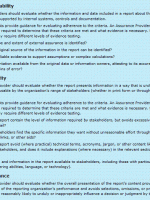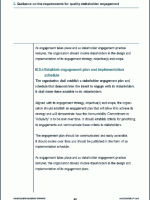Isn’t it wonderful how punnets of soft fruit appear on the shelves every summer? Ready for the eager user to take hope and lovingly smother with cream before gobbling them up in a slightly guilty display of hedonistic decadence.
But think back before the grocer’s shelves and there has to be a way in which the fruit got there in the first place. A method which ensured not only that the fruit got from field to the shelf, but did so without bruising or any other misfortune occurring to such delicate foodstuffs.
This, broadly speaking, is what the Institute for Social and Ethical Accountability’s AA1000 series is all about. It’s not concerned with the fruit of sustainability reporting, the actual metrics.
Rather, it concentrates upon how those metrics are brought about and how appropriate they are to the organisation reporting them. The quality of the reporting process in other words, not the metrics of the report itself.
At its heart AA1000 is all about inclusiveness, the consideration of all stakeholders including future generations and the environment. Around this core the AA1000 series consists of three sets of guidelines, each with their own aim in implementing this inclusiveness.
The best way to demonstrate this is by considering each of the three parts of the AA1000 series individually.
The AA1000 Framework
This concerns itself with the processes an organisation will go through in order to adopt and produce sustainability reporting. It is founded on a set of principles which define what an inclusive reporting process should be.
Those principles are:
- that the processes employed should be implemented in a timely manner and have sufficient scope and relevance
- that the information reported should be of good quality and understandable to anyone reading the report
- that the processes used should be integrated into the organisation’s normal functions and under constant review and refinement
The processes themselves are split into four areas: Planning, Accounting, Reporting & Auditing, and Embedding.
For example, one of the Planning processes is to identify an organisation’s stakeholders. As part of this, P2.5 states that the definition of a stakeholder may include not just the length and type of the relationship, but also both the organisation and the stakeholder’s perception and expectations of the relationship.
The AA1000 Assurance Standard (AA1000AS)
The purpose of this part of the series is to provide a consistent set of standards to help guide an assessor when they are evaluating an organisations sustainability report. These are implemented as a set of simple tests.
The principles which underpin this standard are:
- whether all material which will allow a stakeholder to make an informed judgement has been included (“Materiality”)
- whether the material reported and its effect upon the organisation’s sustainability is fully understood by the organisation (“Completeness”)
- whether the organisation has been receptive of stakeholder concerns, including detailing those concerns and its reaction within the report (“Responsiveness”)
AA1000AS is currently undergoing a revision. At present this is being driven through the use of a wiki, enabling discussion and changes to take place without the need of formal meetings.
An example drawn from this ongoing review concerns the clarity of the report (Section 2.2 in the Guidance for Assessors). Here the following tests need to be applied:
- does the report contain the correct level of information without including unnecessary detail
- can stakeholders find the data they want with relative ease
- are acronyms or other technical terms avoided when possible and explained when necessary
- is the data and information available to all relevant stakeholders, irrespective of ability, language or technology
Please note: these are not the precise tests which may be included in the final version of the revised standard.
AA1000 Stakeholder Engagement Standard (AA1000SES)
Because of its emphasis upon inclusiveness it is natural that the AA1000 series should have a separate section focussing upon how to ensure good quality stakeholder engagement is performed.
Founded on the AA1000AS principles of Materiality, Completeness and Responsiveness, the guidance is divided into three sections: Thinking & Planning, Preparing & Engaging and Responding & Measuring.
For example, when establishing a plan for engaging with its stakeholders (section B3.4), an organisation ought to ensure the following are observed:
- criteria for prioritising engagements are established and communicated to stakeholders
- the engagement plan should be accessible to stakeholders and evolve into a schedule
- as engagement progresses, stakeholders ought to become more involved in the formulation of this schedule
The standard recognises that different organisations engage different stakeholders for different reasons and to different ends. Its aim is simply to ensure that these engagements are appropriate and well conducted.
Conclusion
Large organisations sometimes state that their sustainability report meets both the GRI G3 and the AA1000AS standards. This demonstrates that the report covers the points required by the AA1000AS standard, using metrics provided by the GRI G3 standard.
This is a useful way for sustainability reporting to evolve. It ensures that organisations use both recognised metrics to measure and report their performance and appropriate metrics for their particular circumstances.
The strengthening of standards such as AA1000AS also enables a high level view to be taken, under which differing companies can be compared irrespective of the metrics which they choose to adopt.
A former CTO, Chris has a broad and varied background. He’s been involved with blue chips, consultancies & SMEs across a wide variety of sectors and has worked in Europe, the Middle East and Australia.
In 2007 he decided to combine his knowledge of business and IT with his passion for all things sustainable and has been busy writing ever since. However, his greatest ambition remains to brew the perfect cup of coffee.





